Published in July 2022, this book from publisher Frontline Books, an imprint of Pen & Sword, provides a detailed account of the construction and use of what became known as the Grand Crimean Central Railway, which was the first railway ever employed in warfare, and the first to be used for casualty evacuation, thousands of miles from the UK.
Written by Anthony Dawson, the hardback book measures around 24.77 cm x 16.51 cm, has 272 pages and 90 black and white illustrations. It has a published price of £25, although Pen & Sword currently has it on offer at £18.75, and at the time of writing it can be obtained from Amazon for £17.99.
There would appear to be no link between The Charge of the Light Brigade and the construction of a new railway, but in this book Anthony Dawson shows it was very much reality. The link is the Grand Crimean Central Railway, which was built just a few months after the failed military action involving the British light cavalry led by Lord Cardigan against Russian forces during the Battle of Balaklava.
The author describes the background to the need for a railway as he tells how for weeks the British expeditionary force had been battering away at the defences of Sevastopol, eight miles away from Balaklava.
The book has ten chapters covering Allied Logistics in 1854, the French Army, Supplying the troops in The Crimea, the Military and Railways, Building the Balaklava Railway, The Railways start work, a Transport Revolution, the Ambulance Corps, Running the Railway, the Second Winter, and a conclusion that discusses the use of railways as a new weapon.
In conditions similar to the Battle of the Somme in Word War I, Anthony Dawson describes in great detail how as autumn turned to winter, the track from Balaklava to Sevastopol turned into a muddy quagmire, which became virtually impassable. As horses were finding it increasingly difficult to pull carts up the hills to the siege lines a solution needed to be found, otherwise the entire operation risked becoming a humiliating, disastrous failure.
In gripping detail, the author tells how a UK railway contractor undertook to build a railway from Balaklava, and built a seven-mile long double track line in just seven weeks that enabled food, clothing, and ammunition to reach the front, allowing the British and their French allies to capture Sevastopol and bring the Crimean War to an end.
In comparison with the failure that was the Charge of the Light Brigade, this project was a success of the Crimean War, and in this fascinating book the author tells the story of this largely-unknown project that few will have heard about. It has a great deal of information, statistics, pictures and stories of why the railway was needed, and is remarkable for the number of photographs from the war, barely fifteen years after Fox-Talbot had perfected the photographic process.
Included in the Foreword is a map showing what became the Grand Crimean Central Railway. Unfortunately, the underlying text is very faint and virtually unreadable, even with a magnifying glass. Even with reference to Google Maps, I found it difficult to relate the railway to present-day Crimea, especially as the map does not have a scale. However, it appears that the map is a copy of an original in the US Library of Congress, which is in the public domain and is so much clearer than the extract shown below. The original is titled Plan de la Chersonèse by Capitaine Charles Alexandre Fay, a French staff office, published in 1867 by J Dumaine, Imperial Librarian in Paris. The original also includes a scale that has been omitted from the sample in the book as shown below.
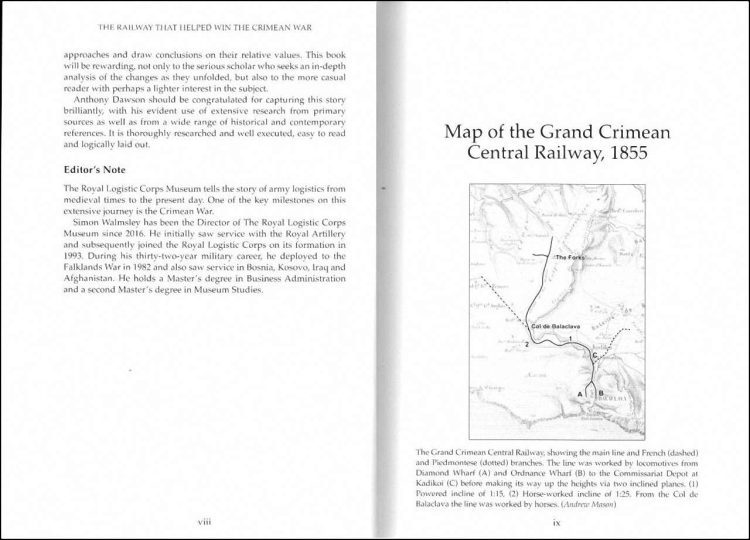
Remarkable for their quality are the photographs below of British troops during the war. What is surprising is the troops on the left attired in apparent dress uniform, although that is in contrast to warmer winter clothing of the ones on the right, although as the caption notes, such warm clothing didn’t arrive until the spring when it was of little use.
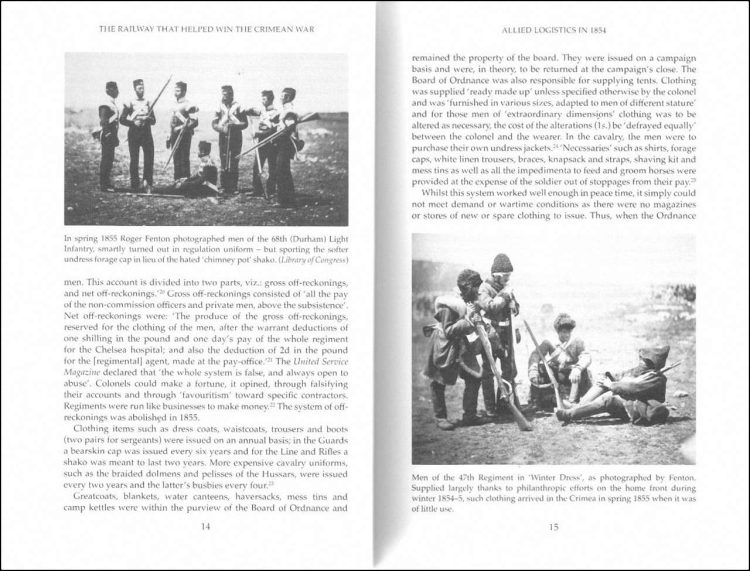
Construction of the railway is well underway in the pages below. Despite the limitations imposed by the quality of the photograph, the railway yard at Balaklava can readily be identified with masts of ships in Balaklava Harbour in the background. The right-hand page below shows a supply of rails that appear to be ready for laying.
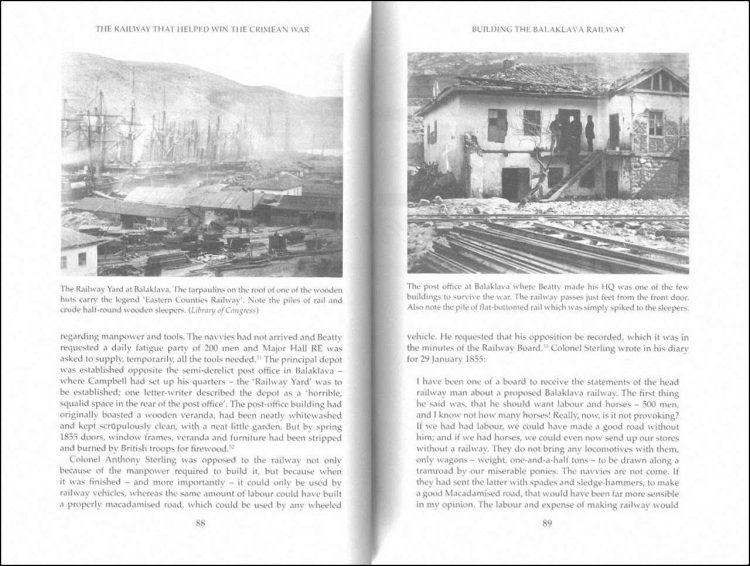
No sooner had the railway been completed, than it was pressed into service. But one wonders what the railway designers were thinking of as the upper photo shows a double-track line with a common centre rail, making it impossible to actually be used as double-track. With echoes of cable-hauled inclines in the UK, the bottom photo shows the winding engine used for cable haulage of the wagons shown in the top photo.
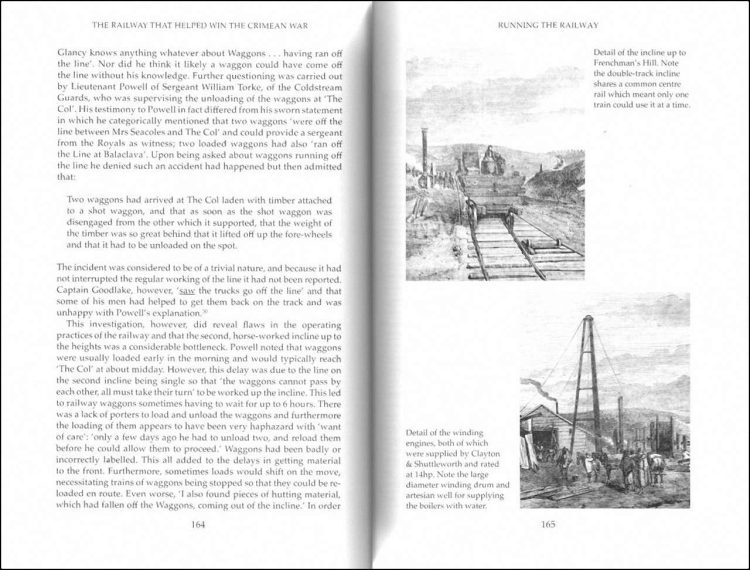
The London & North Western Railway couldn’t have envisaged when it built its Bury type locomotives that some of them would eventually be sent thousands of miles overseas for use as motive power in the Crimean War. The book shows that they were indeed sent overseas to provide valuable war service.
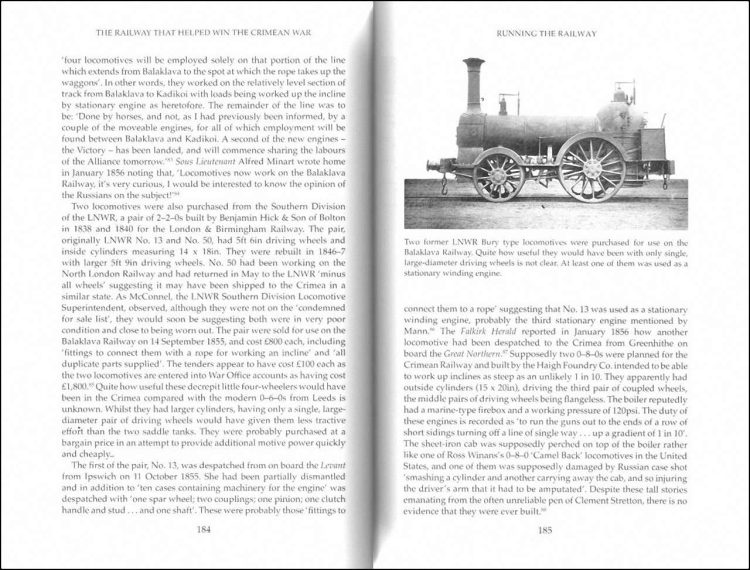
Although the railway did acquire steam locomotives, it mostly relied on horse power in the true sense of the word, as seen in the illustration below. This is taken from a sketch, and as in a previous photograph, it shows Balaklava harbour in the background full of ships.

The level of detail in the book shows that the author has done a huge amount of research, exemplified by the nearly-30 pages of notes and bibliography. His vivid description highlights both the horrific conditions during the winters of 1854 and 1855, and why the war could have been in vain were it not for the railway. However, it is clear that the railway had to fight opposition from elderly senior officers still fighting the Napoleonic Wars. Although there is an incredible amount of detail in the book, the author presents it in a way that is easy to read and understand. For anyone who is interested in logistics, transport, social history or the military, they will thoroughly enjoy this volume. Highly recommended..
The book is available to purchase from Amazon and from Pen & Sword.
We would like to thank Pen & Sword for providing RailAdvent with a copy of the book for review.





Responses